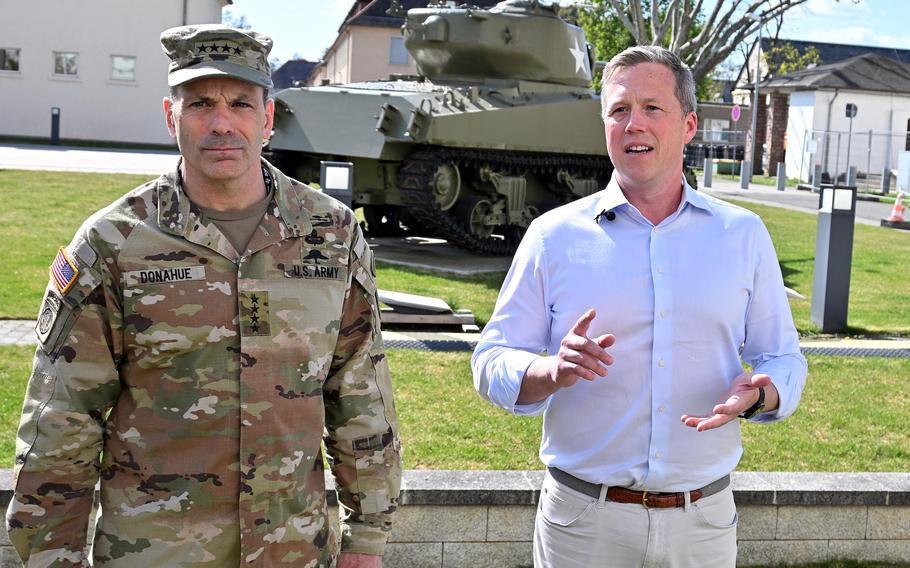
Army Secretary Daniel Driscoll speaks to reporters April 9, 2025, at Clay Kaserne in Wiesbaden, Germany, as U.S. Army Europe and Africa commander Gen. Christopher Donahue listens. In the background is a World War II-era M4 Sherman tank. (Michael Abrams/Stars and Stripes)
WIESBADEN, Germany — Small drones built by American soldiers under the watchful eye of Ukrainian troops gave Army Secretary Daniel Driscoll an up-close look this week at fast-changing combat tactics informed by their partners’ ongoing war with Russia.
Driscoll also refuted reports of any imminent or outsized troop cuts in talks with reporters Wednesday.
Flanked by U.S. Army Europe and Africa’s Gen. Christopher Donahue, Driscoll mingled with members of the 2nd Cavalry Regiment, who commanders say are on the cutting edge in the service’s vision of future warfare.
“The soldiers here are tech-savvy, they’re innovative, they’re hungry, they’re curious,” Driscoll said Wednesday at the Army’s European headquarters during his first visit to the Continent as the service’s new civilian leader.
Driscoll, whose tour through Europe included a stop in Poland on Thursday for a visit with troops there, is focused on the Army’s effort to fast-track new initiatives through a program known as “transforming in contact.”
The aim is to cut through bureaucratic red tape to modernize faster, he said. And Russia’s war in Ukraine looms over much of the Army’s modernization push as it prepares and adapts for an evolving modern battlefield.
“We oftentimes in the Pentagon are talking about the lessons learned in Ukraine ... probably 10 times a day I hear it,” said Driscoll, who on Wednesday also was named acting director of the Bureau of Alcohol, Tobacco, Firearms and Explosives.
Close collaboration with Ukrainian troops has factored into recent Army advances, he said, and a key part of that effort involved getting drones into the hands of soldiers and incorporating them into the ways small units fight.
The Vilseck, Germany-based 2nd Cavalry Regiment is perhaps the only unit in the Army where soldiers themselves are building drones, said Lt. Col. Ryan David, 1st Squadron commander.
The initiative, done without the assistance of any civilian staff or contractors, involves purchase of off-the-shelf parts and construction of drones to individual specifications.
The effort was launched about three months ago in coordination with Ukrainian troops, whose combat experience and hands-on experimentation with drone-building proved invaluable, David said.
Some of the drones on display in Wiesbaden were designed just for surveillance, while others can carry small munitions. The 2nd Cavalry also has built a tethered fiber-optic drone, which can defeat electronic jamming attempts, David said.
That technology has been put to effective use by Ukrainian and Russian forces in recent months.
“We are watching the conflict in Ukraine very closely,” David said.
The U.S. military’s role in supporting Ukraine has changed in recent months, with the Pentagon stepping back from its past position as leader of an international coalition known as the Ukraine Defense Contact Group.
Defense Secretary Pete Hegseth has said Europe must now play the leading role in such efforts, in line with President Donald Trump’s priorities of directing more resources to the Asia-Pacific region.
However, at USAREUR-AF headquarters, American military support for Ukraine continues through its Security Assistance Group Ukraine organization, Army officials said.
Experiences drawn from the group “are priceless for the American people and for our allies around the world,” Driscoll said. “And so I see nothing but continued focus on trying to capture those lessons.”
Still, Driscoll’s visit to Europe comes amid uncertainty about the future U.S. military role on the Continent. Talk has swirled across NATO about the possibility of American troop withdrawals ranging between 10,000 and 20,000.
The Pentagon is reviewing force posture worldwide to assess whether changes need to be made. On Wednesday, Driscoll downplayed the idea of an abrupt change in how the service operates in Europe.
“I have not heard a single thing about having our presence (here) decrease in the near term,” Driscoll said.
He also denied recent media reports that the Army is working on a plan to cut some 90,000 soldiers from its ranks.
“I have not had a single conversation with a single person at the Pentagon that has ever alluded to that size of a cut,” he said.